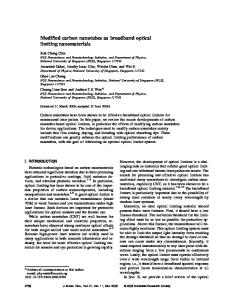Broad-band, High-efficiency Optical Absorbers Derived From Carbon Nanomaterials
- PDF / 944,734 Bytes
- 6 Pages / 612 x 792 pts (letter) Page_size
- 6 Downloads / 335 Views
Broad-band, High-efficiency Optical Absorbers Derived From Carbon Nanomaterials (invited paper) Anupama B. Kaul1*, James Coles1, Michael Eastwood1, Robert Green1, Prabhakar Bandaru2 1
Jet Propulsion Laboratory, California Institute of Technology, Pasadena, CA 91109, USA Jacobs School of Engineering, University of California San-Diego, La Jolla, CA 92093, USA * Corresponding Author, Email: [email protected]
2
ABSTRACT Optical absorption efficiency, an important metric for sensing, radiometric and energy harvesting applications, has been studied theoretically and experimentally in porous, ordered nanostructures, including multi-walled- (MW) carbon nanotubes (CNTs) and single-walled- (SW) CNTs. We have characterized the absorption efficiencies in the 350 nm -7000 nm wavelength range of vertically aligned MWCNT arrays with high site densities synthesized directly on metallic substrates using a plasma-enhanced (PE)- chemical vapor deposition (CVD) process. Our ultrathin absorbers exhibit a reflectance as low as ~ 0.02 % (100 X lower than the benchmark). Such high efficiency absorbers are particularly attractive for radiometry, as well as energy harnessing applications. This work increases the portfolio of materials that can be integrated with such absorbers due to the potential for reduced synthesis temperatures arising from a plasma process. Optical modeling calculations were conducted that enabled a determination of the extinction coefficient in the films. Keywords: carbon nanomaterials, optical absorbers, nanoabsorbers, MWCNTs, PECVD, antireflection coatings 1. INTRODUCTION The ability of nanomaterials to trap light effectively has important implications for their use in energy harnessing, optical blacks for radiometry, as well as detectors. A survey of a host of nanomaterials, such as CdSe nanocrystals [1], graphene [2], and graphene quantum dots [3], reveals the promise such materials have in a wide range of optical applications. In this paper, we report on another type of nanomaterial which is exceptional at trapping incoming light as a result of its unique physical structure, a structure comprised of porous arrays of thin (10-15 nm diameter) vertically oriented multi-walled carbon nanotubes (MWCNTs). Such CNT absorbers have promise in energy harnessing, high sensitivity thermal detectors, and in serving as a reference for quantifying absolute optical power in optoelectronics. Other potential applications include their use in radiative cooling, thermography, antireflection coatings, and optical baffles to reduce scattering.
Porosity in ordered nanostructures has been theoretically [4] shown to enhance optical absorption properties, which has also been verified experimentally in Si-based nanomaterials [5,6], and similar conclusions have also been drawn from theoretical calculations made on low-density arrays of CNTs [7]. Experimentally, the ultra-low reflectance properties arising from MWCNT arrays was recently demonstrated by Yang et al. [8], and Mizuno et al. [9], who conducted emissivity measurements on
Data Loading...










